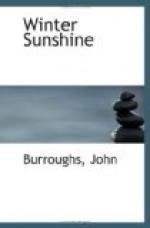WINTER SUNSHINE
I. WINTER SUNSHINE
An American resident in England is reported as saying that the English have an atmosphere but no climate. The reverse of this remark would apply pretty accurately to our own case. We certainly have a climate, a two-edged one that cuts both ways, threatening us with sun-stroke on the one hand and with frost-stroke on the other; but we have no atmosphere to speak of in New York and New England, except now and then during the dog-days, or the fitful and uncertain Indian Summer. An atmosphere, the quality of tone and mellowness in the near distance, is the product of a more humid climate. Hence, as we go south from New York,the atmospheric effects become more rich and varied, until on reaching the Potomac you find an atmosphere as well as a climate. The latter is still on the vehement American scale, full of sharp and violent changes and contrasts, baking and blistering in summer, and nipping and blighting in winter, but the spaces are not so purged and bare; the horizon wall does not so often have the appearance of having just been washed and scrubbed down. There is more depth and visibility to the open air, a stronger infusion of the Indian Summer element throughout the year, than is found farther north. The days are softer and more brooding, and the nights more enchanting. It is here that Walt Whitman saw the full moon
“Pour down Night’s nimbus floods,”
as any one may see her, during the full, from October to May. There is more haze and vapor in the atmosphere during that period, and every pariticle seems to collect and hold the pure radiance until the world swims with the lunar outpouring. Is not the full moon always on the side of fair weather? I think it is Sir William Herschel who says her influence tends to dispel the clouds. Certain it is her beauty is seldom lost or even veiled in this southern or semi-southern clime.
“Floods
of the yellow gold of the gorgeous,
Indolent
sinking sun, burning, expanding the air,”
a description that would not apply with the same force farther north, where the air seems thinner and less capable of absorbing and holding the sunlight. Indeed, the opulence and splendor of our climate, at least the climate of the Atlantic seaboard, cannot be fully appreciated by the dweller north of the thirty-ninth parallel. It seemed as if I had never seen but a second-rate article of sunlight or moonlight until I had taken up my abode in the National Capital. It may be, perhaps, because we have such splendid specimens of both at the period of the year when one values such things highest, namely, in the fall and winter and early spring. Sunlight is good any time, but a bright, evenly tempered day is certainly more engrossing to the attention in winter than in summer, and such days seem the rule, and not the exception, in the Washington winter. The deep snows keep to the north, the heavy rains to the south, leaving a blue space central over the border States. And there is not one of the winter months but wears this blue zone as a girdle.




